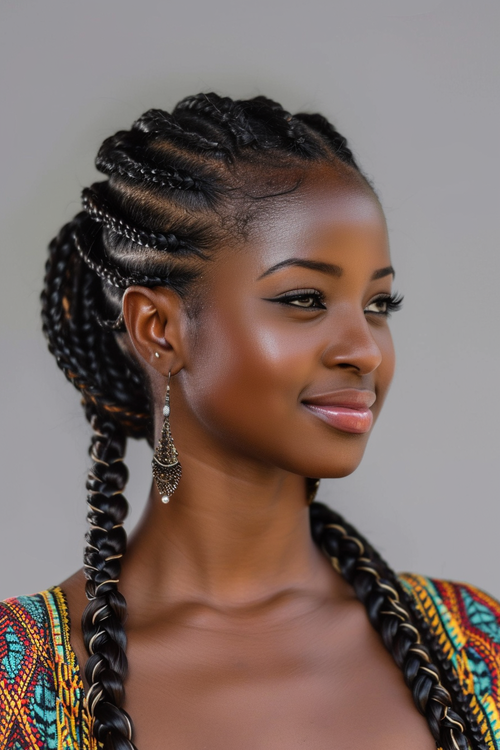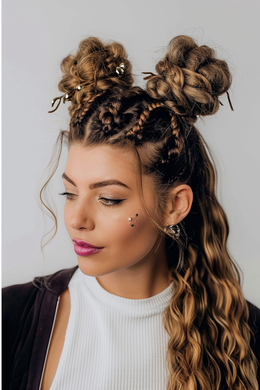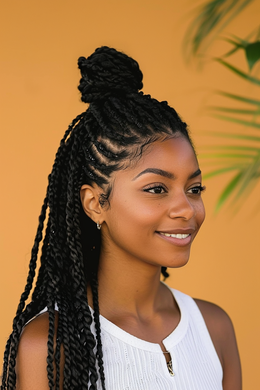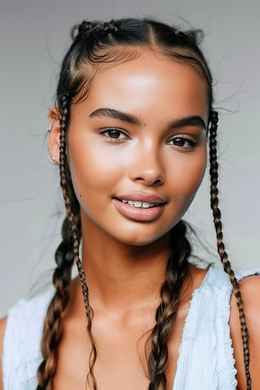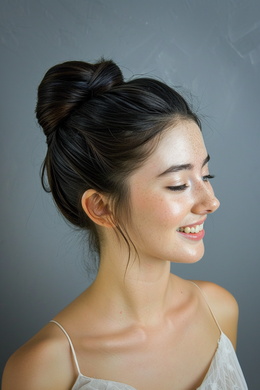African Hairstyles: 41+ Traditional Styles Reimagined
Discover the world of stunning African hairstyles, from intricate cornrows to symbolic dreadlocks. Let yourself be inspired by the creativity and significance of these looks and express your style.
Table of content
Cornrows
Cornrows are much more than just a hairstyle – they make a real statement! Deeply rooted in African culture, they embody style, history, and craftsmanship. But beware, they require skill and time! You should be aware that the hours of braiding can be a challenge for your mane. Make sure that the braids are not pulled too tightly against your scalp to prevent hair damage. However, if you look forward to the final result, you will be rewarded with a stunning, summery look that could have emerged under the African sun. Remember, regular hair washes and conditioning masks after undoing the cornrows are a must to restore your hair's bounce!
Bantu Knots
Bantu Knots are not only a stylish eye-catcher but also a great protective hairstyle for your mane. Want to give your hair a little break? Then you should definitely try out this trendy look. Grab some high-quality hair pomade to nourish and seal your strands. With a little skill, twist your hair into small buns that lock in moisture. Bonus: After a day or two in the knots, you'll be rewarded with fantastic Bantu Outs, which are gorgeous waves—and the best part? It's super easy! So go ahead, get those Bantu Knots, and show the world your unique style!
Dreadlocks
Dreadlocks are a timeless statement and reflect an individual attitude. They captivate with natural elegance and offer an expression of personality. The path to cool dreads is easier than you might think: Hair at least 4 inches long can be styled using the backcombing and crochet method—no wax needed! This may shorten the hair by about a third, but doesn't take away from their splendor. For those who still prefer long hair, extensions are a helpful option. They not only provide additional length but also luxurious volume—choices range from synthetic to natural hair variations. Properly care for your dreads and they will accompany you for a lifetime. Consider special products like dread soap or spray, and have them maintained regularly. The effort is worth it, as well-cared-for dreadlocks express your unique lifestyle. Experience the variety, play with accessories, and enjoy the freedom that dreadlocks offer you!
Braids
Braids are much more than just a hairstyle – they are an art form that expresses personality and creativity. Whether it's chic box braids with their distinctive rectangular pattern or playful ombre braids that captivate with a seamless color transition, the possibilities are virtually limitless! You can visually lengthen your hair by braiding in synthetic hair, make it appear fuller, or revolutionize your styling with a burst of vibrant colors. The durability also leaves nothing to be desired: with a wear time of 2 to 4 months, you can enjoy your style for a long period. And the best part? Braids suit all hair types! Impressive results can be achieved starting from a hair length of about 6 inches. Get inspired and dare to try something new with braids!
Afro
Imagine strolling down the street and all heads are turning towards you – that is the magic of a magnificent Afro! This iconic hairstyle is more than just a haircut; it is an ode to the natural power of your hair. Wearing your Afro shows respect and love for the natural splendor of your curls. It is important not to neglect hair care. Nutrient-rich oils and gentle washing routines help keep your hair healthy and preserve the enigmatic beauty of your natural crown. So, dare to unleash your Afro in its full glory – you'll see how it not only elevates your look but also gives wings to your confidence!
Traditional Hair Care Techniques in Africa
In African hair care culture, you find fascinating techniques that have been passed down through generations. Traditionally, people here use natural products obtained directly from their surroundings. Shea butter, pure plant-based oils like coconut or argan oil, and aloe vera gel are just a few of the natural wonders that not only nourish but also keep hair and scalp healthy. Selected herbs and plant extracts are also used for hair care and styling, to strengthen and nourish the hair. These techniques not only preserve the hair's shine but also maintain its flexibility and resilience. The art of finger-detangling, which involves carefully unraveling hair without a comb, is another method that protects the natural hair structure and minimizes the risk of breakage.
Protection and Preservation of African Hair Textures
To protect and preserve the unique nature of African hair textures, customized and mindful care is essential. The hair should be regularly moisturized to combat dryness. Light moisturizing sprays and oils that do not weigh down the hair are ideal for keeping curls and waves elastic. Gentle handling is important during daily care to avoid damaging the delicate structure. Protective hairstyles, such as cornrows, braids, or twists, help shield the hair from external factors like sun exposure and friction, while also promoting hair growth by allowing the hair to rest. It's also important to regularly loosen these styles to prevent tension and allow the scalp to breathe.
Symbolism and Cultural Significance of African Hairstyles
African hairstyles are deeply rooted in symbolic and cultural meanings. Cornrows, for example, the hairstyle braided closely to the scalp, served in the past not only as a fashion statement but also as a means of secret communication. Likewise, dreadlocks are not just a symbol of Rastafarian belief but also an expression of personal freedom and resistance to conventional beauty standards. Hairstyles like Bantu Knots celebrate, much like the Afro, African identity and cultural heritage. They often serve as an empowerment tool for self-expression and community belonging. Wearing these hairstyles is, for many, a sign of pride and a way to honor and preserve a rich cultural history. The diversity and beauty of African hairstyles reflect the creativity and resilience of the African continent and inspire people worldwide.


